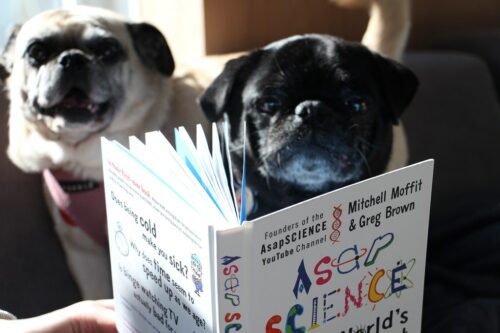Ever wondered what our appendix actually does? Or why you feel like sneezing when you pluck your eyebrows? How about why the spider in your bathroom only has six legs? Well, Hank Green has an answer for that. You might have encountered Hank on his CrashCourse channel, which he co-founded with his brother John, while you were cramming for that high school biology test. Now he’s migrated to TikTok, where he shares some of his hot takes and answers some of the scientific questions that may (or may not) be on your mind—all while maintaining his ever-familiar eccentric personality between two of his largest platforms.
Hank Green is one of many creators on TikTok who use their platforms to talk about science. In his most popular TikToks, his followers submit videos asking any question on their minds, and Hank directly posts his responses on his page. The TikToks with the most views match his high-energy YouTube persona and use lightheartedness and sarcasm to point out that he is not always right and should not be the only scientific authority his viewers consult.
You might also remember the aesthetic whiteboard illustrations and the infamous “Periodic Table Song” from AsapScience’s YouTube channel. Well, Greg and Mitch, the channel’s creators, have also brought their platform from YouTube to TikTok. Still, their style of disseminating information is a little different. Some of their most popular videos are reminiscent of the illustrative visuals they are known for on their YouTube channel. But others involve social commentary on STEM, dance breaks with captions calling attention to our reckless destruction of the planet, and Greg and Mitch’s everyday thoughts and hot takes.
Hank, Greg, and Mitch never seemed to have sacrificed their personas on TikTok. Of course, their long-form content on YouTube can’t necessarily be translated onto TikTok. Instead, TikTok allows their audiences to see a more personable side that may not have been portrayed in the same way on their main YouTube channels. TikTok’s sixty-second time limit better accommodates short tidbits than complex concepts. This allows them to focus more on aspects that enable them to better connect with their audience—for example, Q&As or talking about their personal lives.
As for creators that have built their platforms solely on TikTok, Darrion Nguyen (@lab_shenanigans) and Hailey Levi (@chaoticallyscience) are worth checking out. Many of Darrion’s TikToks use sounds from reality shows to help playfully illustrate concepts helpful for studying biochemistry, while others showcase some of his after-hours antics as a research technician. One of Darrion’s most popular videos shows him pasting images of James Watson, Francis Crick, and Maurice Wilkins in his Mean Girls-inspired Burn Book. He alludes to how they snubbed Rosalind Franklin of her deserved recognition for identifying the double helix of DNA. The humor and classic references that Darrion incorporates are starting points for a social commentary on science and science history.
Meanwhile, Hailey is a Ph.D. student who creates videos to prove that science isn’t as dull or out-of-touch as it is sometimes portrayed to be. Her most recent posts showcase her having fun during her after-hours, whether she is switching on the vortex mixer to Gloria Estefan and Miami Sound Machine’s “Conga” or doing the Perfect Match trend with her lab mates. But she also puts out advice on starting graduate school and uses her platform to talk about being a person of color in STEM. Periodically, she educates viewers on prominent black women in STEM. She empowers her audience based on the importance of seeing other black women making significant strides in field in which they’re underrepresented. From Hailey’s content, you feel like you’re connecting with a supportive peer mentor and easy-going friend.
What do all of these creators have in common? They have all found ways to make attention-grabbing videos that promote science—but not exactly in a format that is as high-stakes as your nine AM chemistry class or as passive as your asynchronous math class. Because these creators only have sixty seconds, the points that they communicate must be incredibly concise and clear. Moreover, they sprinkle in their personalities and humor to make STEM learning more engaging and more fun. Maybe Hank’s status as a Gen-X member makes his TikToks more entertaining as he attempts to understand the questions coming from his majority Gen-Z audience. Meanwhile, Darrion’s use of pop culture helps boost his relatability in his videos. It is no wonder that TikTok has become a popular destination for access to science and scientific news.
Citations
Brown, G. & Moffit, M. [@asapscience] (n.d.) AsapSCIENCE [TikTok profile]. TikTok. Retrieved February 24, 2021
Green, H. [@hankgreen1] (n.d.) Hank Green [TikTok profile]. TikTok. Retrieved February 24, 2021, from https://www.tiktok.com/@hankgreen1?lang=en
Levi, H. [@chaoticallyscience] (n.d.) Hailey [TikTok profile]. TikTok. Retrieved February 24, 2021, from https://www.tiktok.com/@chaoticallyscience?lang=en
Nguyen, D. [@lab_shenanigans] (n.d.) Darrion Nguyen [TikTok profile]. TikTok. Retrieved February 24, 2021, from https://www.tiktok.com/@lab_shenanigans?lang=en

